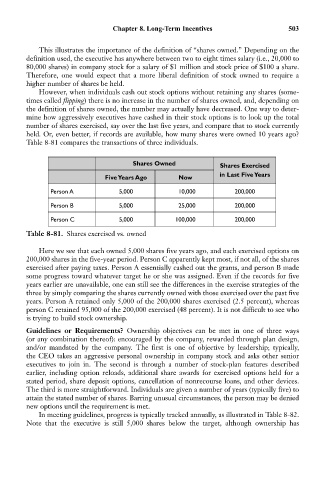Page 517 - Bruce Ellig - The Complete Guide to Executive Compensation (2007)
P. 517
Chapter 8. Long-Term Incentives 503
This illustrates the importance of the definition of “shares owned.” Depending on the
definition used, the executive has anywhere between two to eight times salary (i.e., 20,000 to
80,000 shares) in company stock for a salary of $1 million and stock price of $100 a share.
Therefore, one would expect that a more liberal definition of stock owned to require a
higher number of shares be held.
However, when individuals cash out stock options without retaining any shares (some-
times called flipping) there is no increase in the number of shares owned, and, depending on
the definition of shares owned, the number may actually have decreased. One way to deter-
mine how aggressively executives have cashed in their stock options is to look up the total
number of shares exercised, say over the last five years, and compare that to stock currently
held. Or, even better, if records are available, how many shares were owned 10 years ago?
Table 8-81 compares the transactions of three individuals.
Shares Owned Shares Exercised
in Last Five Years
Five Years Ago Now
Person A 5,000 10,000 200,000
Person B 5,000 25,000 200,000
Person C 5,000 100,000 200,000
Table 8-81. Shares exercised vs. owned
Here we see that each owned 5,000 shares five years ago, and each exercised options on
200,000 shares in the five-year period. Person C apparently kept most, if not all, of the shares
exercised after paying taxes. Person A essentially cashed out the grants, and person B made
some progress toward whatever target he or she was assigned. Even if the records for five
years earlier are unavailable, one can still see the differences in the exercise strategies of the
three by simply comparing the shares currently owned with those exercised over the past five
years. Person A retained only 5,000 of the 200,000 shares exercised (2.5 percent), whereas
person C retained 95,000 of the 200,000 exercised (48 percent). It is not difficult to see who
is trying to build stock ownership.
Guidelines or Requirements? Ownership objectives can be met in one of three ways
(or any combination thereof): encouraged by the company, rewarded through plan design,
and/or mandated by the company. The first is one of objective by leadership; typically,
the CEO takes an aggressive personal ownership in company stock and asks other senior
executives to join in. The second is through a number of stock-plan features described
earlier, including option reloads, additional share awards for exercised options held for a
stated period, share deposit options, cancellation of nonrecourse loans, and other devices.
The third is more straightforward. Individuals are given a number of years (typically five) to
attain the stated number of shares. Barring unusual circumstances, the person may be denied
new options until the requirement is met.
In meeting guidelines, progress is typically tracked annually, as illustrated in Table 8-82.
Note that the executive is still 5,000 shares below the target, although ownership has

